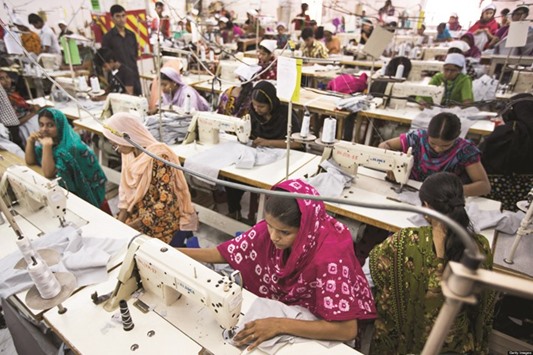South Asia’s clothing and textiles industry can create millions of jobs for the region’s working-age women, boosting economic growth and helping improve children’s health and education, a World Bank report said.
The industry is already the most female-intensive in much of the region, women making up 71% of its workforce in Sri Lanka, 35% in India and 34% in Bangladesh. In Pakistan, its share of women workers is second to agriculture.
“South Asia needs to create jobs in labour-intensive industries where it enjoys a comparative advantage – such as apparel – to employ its burgeoning youth and attract more women into the workforce,” the report released yesterday said.
“South Asian households with women working, especially in the textile and apparel sector in India and Pakistan, tend to have fewer young children on average,” it said.
Higher wages in China, the world’s largest clothing exporter, are driving global brands to seek cheaper alternatives in countries including Bangladesh, India, Pakistan and Sri Lanka.
South Asia is best placed to lure these businesses with its lower wages and expanding young population, even though recent industrial disasters have raised questions about safety and the conditions of workers in these countries.
The industry employs about 4.7mn workers in the formal sector, and several million more informally, making up about 40% of the region’s manufacturing employment.
Its ability to lure unskilled and semi-skilled women is particularly important, as South Asia has one of the lowest female labour force participation rates in the world of about 32%, compared with East Asia’s 62%, the report said.
Countries with greater female labour force participation generally see later marriages, fewer children, better nutrition and school enrolment, and higher gross domestic product, according to the World Bank.
“The apparel sector offers a promising and realistic entry point for women into the formal labour force, thanks to a high wage premium compared to agriculture,” the report said.
“As apparel exports increase, the rising demand for female labour pulls women from agriculture and other informal sectors.”
Average wages in the industry range from about $0.51 per hour in Bangladesh to about $1.06 in India, compared with $2.60 in China, according to 2012 data compiled by the World Bank.
As output increases to meet higher demand, a 1% increase in the expected wage raises the likelihood of women joining the labour force by between 16% in Pakistan and 89% in Sri Lanka, the World Bank estimates.
Despite the large number of women the industry employs, however, female workers lack a voice and representation in Bangladesh, the region’s largest exporter by value.
Regulatory capacity is also weak in Bangladesh, even though scrutiny has increased in the wake of the Rana Plaza disaster. Three years after the disaster that killed more than 1,100 factory workers, the rights and safety of workers in the region are in greater focus, but progress in fixing problems in the supply chain is slow, experts and activists say.
In India, compliance is limited in the informal sector, where most workers are employed. Overtime is a serious problem, and child labour is common, with reports also of exploitation and sexual harassment of women.
In addition, the region faces growing competition from Southeast Asian countries including Cambodia, Indonesia and Vietnam.
Business / Business
S Asia clothing industry can employ millions more women, boost growth: World Bank

Workers sew garments at a factory in Dhaka. The textile industry is the most female-intensive sector in Asia with women making up 71% of its workforce in Sri Lanka, 35% in India and 34% in Bangladesh.


